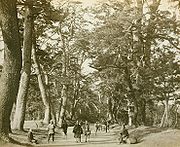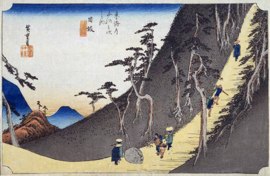
Tokaido (road)
Encyclopedia

Edo Five Routes
The were the five major roads that started at Edo during the Edo period, the most important of which was the Tōkaidō, which linked Edo and Kyoto...
of the Edo period
Edo period
The , or , is a division of Japanese history which was ruled by the shoguns of the Tokugawa family, running from 1603 to 1868. The political entity of this period was the Tokugawa shogunate....
, connecting Edo
Edo
, also romanized as Yedo or Yeddo, is the former name of the Japanese capital Tokyo, and was the seat of power for the Tokugawa shogunate which ruled Japan from 1603 to 1868...
(modern-day Tokyo
Tokyo
, ; officially , is one of the 47 prefectures of Japan. Tokyo is the capital of Japan, the center of the Greater Tokyo Area, and the largest metropolitan area of Japan. It is the seat of the Japanese government and the Imperial Palace, and the home of the Japanese Imperial Family...
) to Kyoto
Kyoto
is a city in the central part of the island of Honshū, Japan. It has a population close to 1.5 million. Formerly the imperial capital of Japan, it is now the capital of Kyoto Prefecture, as well as a major part of the Osaka-Kobe-Kyoto metropolitan area.-History:...
in Japan
Japan
Japan is an island nation in East Asia. Located in the Pacific Ocean, it lies to the east of the Sea of Japan, China, North Korea, South Korea and Russia, stretching from the Sea of Okhotsk in the north to the East China Sea and Taiwan in the south...
. Unlike the inland and less heavily travelled Nakasendō
Nakasendo
The , also called the , was one of the five routes of the Edo period, and one of the two that connected Edo to Kyoto in Japan. There were 69 stations between Edo and Kyoto, crossing through Musashi, Kōzuke, Shinano, Mino and Ōmi provinces...
, the Tōkaidō travelled along the sea coast of eastern Honshū
Honshu
is the largest island of Japan. The nation's main island, it is south of Hokkaido across the Tsugaru Strait, north of Shikoku across the Inland Sea, and northeast of Kyushu across the Kanmon Strait...
, hence the route's name.
Traveling the Tōkaidō

Kago
A ' is a Japanese type of litter, suspended by a single crossbeam, carried by two men, usually used to transport one person at a time. The front and back of the kago is always covered; the sides can be left open, or encased by folding screens. This should not be confused with the more elaborate...
. Women were forbidden to travel alone and had to be accompanied by men. Other restrictions were also put in place for travelers, but, while severe penalties existed for various travel regulations, most seemed not to be enforced.
There were government-sanctioned post stations
Shukuba
were post stations during the Edo period in Japan, generally located on one of the Edo Five Routes or one of its sub-routes. They were also called shukueki . These post stations were places where travelers could rest on their journey around the nation...
along the Tōkaidō for travelers to rest in. These stations consisted of porter stations and horse stables, as well as lodging, food and other places a traveler may visit. The original Tōkaidō was made up of 53 stations
53 Stations of the Tokaido
The are the rest areas along the Tōkaidō, which was a coastal route that ran from Nihonbashi in Edo to Sanjō Ōhashi in Kyoto.-Stations of the Tōkaidō:...
between the termination points of Edo and Kyoto. The 53 stations were taken from the 53 Buddhist saints that Buddhist acolyte Sudhana
Sudhana
Sudhanakumâra , mainly known as Sudhana, translated as Child of Wealth, is the main protagonist in the next-to-last and longest chapter of the Avatamsaka Sutra. Sudhana appears in Buddhist, Taoist and folk stories; in most of them he is one of the acolytes of the Bodhisattva Avalokitesvara and is...
visited to receive teachings in his quest for enlightenment. At a few points along the route, there were checkpoints where travelers had to present traveling permits
Passport
A passport is a document, issued by a national government, which certifies, for the purpose of international travel, the identity and nationality of its holder. The elements of identity are name, date of birth, sex, and place of birth....
to pass.
Writing about Tōkaidō
Travel, particularly along the Tōkaidō, was a very popular topic in art and literature at the time. The famous artist HiroshigeHiroshige
was a Japanese ukiyo-e artist, and one of the last great artists in that tradition. He was also referred to as Andō Hiroshige and by the art name of Ichiyūsai Hiroshige ....
depicted each of the 53 post stations
53 Stations of the Tokaido
The are the rest areas along the Tōkaidō, which was a coastal route that ran from Nihonbashi in Edo to Sanjō Ōhashi in Kyoto.-Stations of the Tōkaidō:...
(shukuba
Shukuba
were post stations during the Edo period in Japan, generally located on one of the Edo Five Routes or one of its sub-routes. They were also called shukueki . These post stations were places where travelers could rest on their journey around the nation...
) of the Tōkaidō in his work The Fifty-Three Stations of the Tōkaidō, and the haiku
Haiku
' , plural haiku, is a very short form of Japanese poetry typically characterised by three qualities:* The essence of haiku is "cutting"...
poet Matsuo Bashō
Matsuo Basho
, born , then , was the most famous poet of the Edo period in Japan. During his lifetime, Bashō was recognized for his works in the collaborative haikai no renga form; today, after centuries of commentary, he is recognized as a master of brief and clear haiku...
traveled along the road.
A great many guidebooks of famous places were published and distributed at this time, and a culture of virtual tourism through books and pictures thrived. Jippensha Ikku
Jippensha Ikku
was the pen name of Shigeta Sadakazu , a Japanese writer active during the late Edo period of Japan. He lived primarily in Edo in the service of samurai, but also spent some time in Osaka as a townsman...
's Tōkaidōchū Hizakurige, translated as "The Shank's Mare", is one of the more famous novels about a journey along the Tōkaidō.
In the early 1980s, inspired by Hiroshige, American artist Bill Zacha
Bill Zacha
Bill Zacha was an artist and entrepreneur who founded the in Mendocino, California and by doing so started the artistic revival of Mendocino....
traveled the Tokaido stations. He created a series of 55 serigraphs, each depicting one stop along the Tokaido way, and printed 100 copies of each design. These were collected in the 1985 book Tokaido Journey, along with Bill's recollections (in both English and Japanese) of traveling the road and the people he encountered.
Ōsaka Kaidō
In 1619, the Ōsaka Kaidō (大阪街道) was established, adding four more stations after Ōtsu-juku. These additions extended the route to KōraibashiKoraibashi
lit. "Goryeo Bridge" is a bridge located in Chūō-ku in the city of Osaka, Osaka Prefecture, Japan. It crosses over the Higashi Yokobori River and shares its name with the surrounding area.-Naming:...
in Osaka
Osaka
is a city in the Kansai region of Japan's main island of Honshu, a designated city under the Local Autonomy Law, the capital city of Osaka Prefecture and also the biggest part of Keihanshin area, which is represented by three major cities of Japan, Kyoto, Osaka and Kobe...
. This extension was also called the Kyōkaidō (京街道), or was described as being a part of the 57 stations of the Tōkaidō.
Modern-day Tōkaidō
Today, the Tōkaidō corridor is the most heavily travelled transportation corridor in Japan, connecting Greater Tokyo (including the capital Tokyo as well as Japan's second largest city YokohamaYokohama
is the capital city of Kanagawa Prefecture and the second largest city in Japan by population after Tokyo and most populous municipality of Japan. It lies on Tokyo Bay, south of Tokyo, in the Kantō region of the main island of Honshu...
) to Nagoya (fourth largest), and then to Osaka
Osaka
is a city in the Kansai region of Japan's main island of Honshu, a designated city under the Local Autonomy Law, the capital city of Osaka Prefecture and also the biggest part of Keihanshin area, which is represented by three major cities of Japan, Kyoto, Osaka and Kobe...
(third largest) via Kyoto. The Tokyo-Nagoya-Kyoto-Osaka route is followed by the JR Tōkaidō Main Line
Tokaido Main Line
The is the busiest trunk line of the Japan Railways Group , connecting Tōkyō and Kōbe stations. It is long, not counting its many freight feeder lines around the major cities...
and Tōkaidō Shinkansen, as well as the Tōmei
Tomei Expressway
The is a national expressway on the island of Honshū in Japan. It is operated by Central Nippon Expressway Company. It is a part of Asian Highway Network -Naming:The word Tōmei is an acronym consisting of two kanji characters...
and Meishin
Meishin Expressway
The is a toll expressway in Japan. It runs from a junction with the Tomei Expressway in Nagakute, Aichi west to Nishinomiya, Hyōgo . It is the main road link between Osaka and Nagoya, and, along with the Tōmei Expressway, forms the main road link between Osaka and Tokyo...
expressways. A few portions of the original road can still be found, however, and in modern times at least one man has managed to follow and walk much of it.
See also
- Edo Five RoutesEdo Five RoutesThe were the five major roads that started at Edo during the Edo period, the most important of which was the Tōkaidō, which linked Edo and Kyoto...
- Japan National Route 1
- Tōkaidō Main LineTokaido Main LineThe is the busiest trunk line of the Japan Railways Group , connecting Tōkyō and Kōbe stations. It is long, not counting its many freight feeder lines around the major cities...
- Tōkaidō Shinkansen
- Namamugi IncidentNamamugi IncidentThe was a samurai assault on foreign nationals in Japan on September 14, 1862, which resulted in the August 1863 bombardment of Kagoshima, during the Late Tokugawa shogunate...
External links
- Walk the Tōkaidō - an interactive tour down the road.
- Travel Tōkaidō - from U.S. Public Broadcasting Service (PBS)
- The Old Tōkaidō: The Eastern Sea Road - Teacher James Baquet's log of a walk along the entire Tōkaidō, with photos and comparisons to Hiroshige's prints.
- The Fifty Three Stations of the Tokaido Road - by Ando Hiroshige
- Arranged by station
- Tōkaidō map

